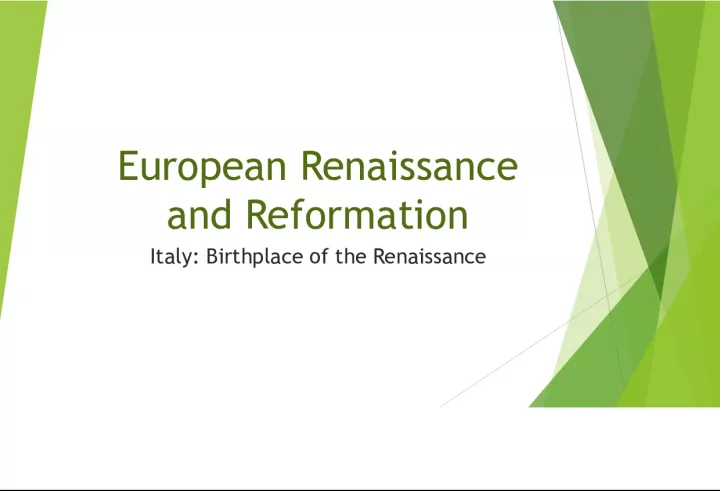The Birthplace of the Renaissance: Italy's Advantages


This article explores the factors that led to Italy being the epicenter of the European Renaissance and the Protestant Reformation. The major city-states of Italy, such as Florence and
- Uploaded on | 0 Views
-
 shchastibog
shchastibog
About The Birthplace of the Renaissance: Italy's Advantages
PowerPoint presentation about 'The Birthplace of the Renaissance: Italy's Advantages'. This presentation describes the topic on This article explores the factors that led to Italy being the epicenter of the European Renaissance and the Protestant Reformation. The major city-states of Italy, such as Florence and. The key topics included in this slideshow are . Download this presentation absolutely free.
Presentation Transcript
Slide1European Renaissanceand Reformation Italy: Birthplace of the Renaissance
Slide4Italy’s Advantages City States Wealthy Merchants Greece and Rome
Slide5City States Use text page 37 Why are the major City-States primarily located near the sea? How would these City-States ideal breeding grounds for intellectual revolution? What contributed to the Italians pursuing intellectual interests such as Art?
Slide6Merchants and the Medici Use the text pgs. 37-38 How did the merchants come to control the politics of the City- States? Who were the Medici and why were they so powerful?
Slide10The Renaissance ManAll educated men should create art! A man who excels in many fields is praised as a “universal man” of Renaissance man. A man should be charming, witty, and well educated. He should sing, dance, play music, and write poetry. As well as be a skilled rider, wrestler, and swordsman.
Slide11The Renaissance Woman According to the Courtier , upper- class women were expected to be charming but not to seek fame. A woman should inspire art; not create art. Renaissance women were not to influence politics However women like Isabella D’Este (pictured) was very involved in politics and the arts.
Slide12The Renaissance Revolutionizes Art
Slide13The Renaissance Revolutionizes Art A realistic Style- copied from classical models. Influenced by the Greek and Roman artist Painters used the technique of perspective , which shows a three dimensions on a flat surface
Slide14Leonardo da Vinci
Slide15Leonardo, Renaissance Man A painter, sculptor, inventor and scientist. A true Renaissance Man He studied how muscles move and how veins in a leaf are arranged. He would incorporate his findings in his art.
Slide16Leonardo da Vinci’s Inventions
Slide17Raphael Sanzio
Slide18Raphael Advances Realism Student of Michelangelo and Leonardo His Favorite subject was the Madonna and child (top right) he often portrayed them as gentle and calm In his greatest achievement, Raphael filled the walls of Pope Julius II’s library with paintings School of Athens (left)
Slide19Michelangleo Michelangelo di Lodovico Buonarroti Simoni, commonly known as Michelangelo, was an Italian sculptor, painter, architect, poet, and engineer of the High Renaissance who exerted an unparalleled influence on the development of Western art.
Slide20Michelangelo Buonarrotihttp://youtu.be/NXyi82dYRxE
Slide22Renaissance Literature Renaissance writers began to develop the techniques still used today. They began writing in the vernacular (local language) Wrote for self-expression and portrayed the individuality of their subjects.
Slide23Dante Dante began writing his works in Italian instead of classical Latin. His most famous work is “Inferno” which portrays a man’s journey through the nine circles of Hell.
Slide24Dante’s “Inferno”
Slide25Francesco PetrarchFather of Renaissance Humanism Petrarch wrote in both the vernacular (Italian) and Latin. Famous for his sonnets (14 line poem) Who is Laura?
Slide26Machiavelli Advises Rulers Niccol ò Machiavelli wrote a political guidebook entitled “The Prince”. In “The Prince”, Machiavelli examines how a ruler can gain power and keep it. He believed that for a ruler to succeed in a wicked world, a leader had to be as strong as a lion and shrewd as a fox. He was not concerned with moral correctness, only political effectiveness.
Slide27Women Writers Women writers of the Renaissance wrote about personal subjects, not politics. Vittoria Colonna wrote sonnets with Michelangelo and helped to publish the Courtier.